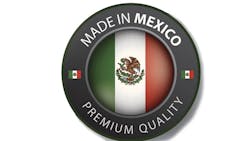One of the most dramatic effects of the near-shoring trend can be seen in the steady rise of Mexico's economy. Currently ranked as the 14th largest economy in the world, Mexico is on track to becoming the fifth largest global economy by 2050, according to investment firm Goldman Sachs.
In the 2015 Third-Party Logistics Study, a global collaborative study conducted by Capgemini Consulting, Penn State University, Penske, Korn Ferry as well as IndustryWeek, 40% of manufacturers indicated that they have moved some operations to Mexico. The majority (55%) of those involve moves from the U.S. to Mexico, with China accounting for 36% and Canada 9% of the moves.
"Mexico's location and free-trade agreements have been incentivizing manufacturers to continue investing there," says Marc Althen, president of Penske Logistics. His company has operated in Mexico for nearly two decades, Althen notes, and they continue to see a favorable business environment for logistics, both in the short and longer term.
According to survey respondents, the main reasons companies are turning to Mexico include lower operating costs, favorable taxes and tariffs, reduced freight transit time and a closer proximity to sources of supply. On the other hand, manufacturers are still somewhat intimidated by some of Mexico's well-publicized challenges, notably crime and security concerns, infrastructure problems and complex regulations.
While many point to the North American Free Trade Agreement (NAFTA) as the beginning of Mexico's resurgence, that country's growth has been sustained by the automotive and aviation sectors, notes Robert Queen, director of the U.S. Commercial Service's El Paso Export Assistance Center. Those sectors, he notes, have set the pace in driving up quality standards for Mexican industry in recent years. "We're also seeing vast improvement in the quality of the Mexican workforce, such as training in manufacturing and engineering," which Queen says contributes to the demand for high-quality manufacturing.
Geographic proximity offers "a huge advantage" when supplying material to Mexican manufacturers, Queen adds. "In an effort to hold down costs, many manufacturers store a small inventory, and therefore they rely on their suppliers to deliver material on a consistent schedule."
This trend, Queen points out, is driving the co-manufacturing trend developing between the United States and Mexico. Many foreign manufacturers in Europe and Asia have taken notice of this trend, he notes, and as a result they are increasing investment in North America.
About the Author
Dave Blanchard
Senior Director of Content
Focus: Supply Chain
Call: (941) 208-4370
Follow on Twitter @SupplyChainDave
During his career Dave Blanchard has led the editorial management of many of Endeavor Business Media's best-known brands, including IndustryWeek, EHS Today, Material Handling & Logistics, Logistics Today, Supply Chain Technology News, and Business Finance. He also serves as senior content director of the annual Safety Leadership Conference. With over 30 years of B2B media experience, Dave literally wrote the book on supply chain management, Supply Chain Management Best Practices (John Wiley & Sons, 2010), which has been translated into several languages and is currently in its second edition. He is a frequent speaker and moderator at major trade shows and conferences, and has won numerous awards for writing and editing. He is a voting member of the jury of the Logistics Hall of Fame, and is a graduate of Northern Illinois University.

